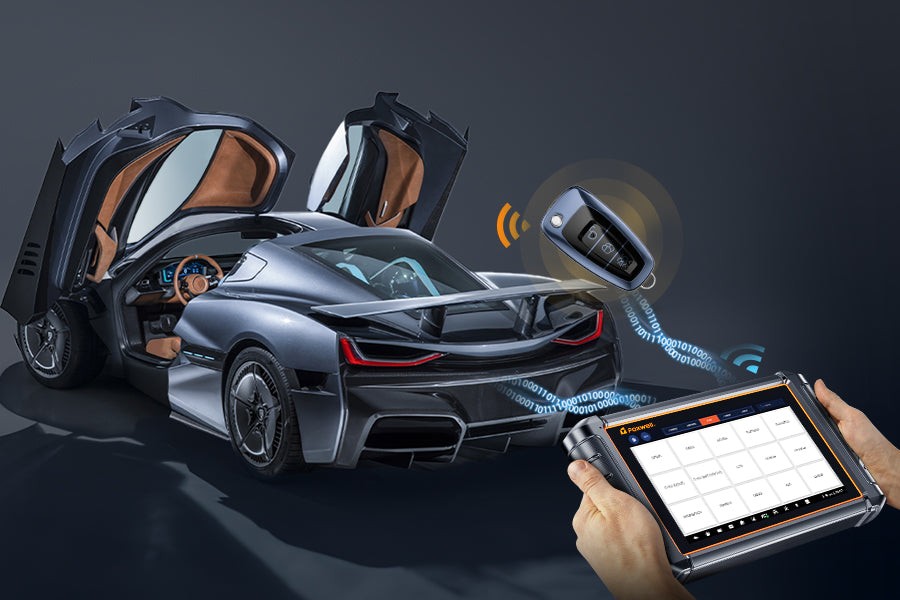Car key programming is no longer a niche skill but a fundamental service in modern automotive care. As vehicle security systems become increasingly sophisticated with smart keys and complex immobilizers, the ability to program car keys using scanners has become indispensable. This guide explores how to become proficient in car scanner programming, transforming you into an expert capable of handling today’s automotive key challenges. We’ll delve into the essential knowledge, practical steps, and future trends in this rapidly evolving field, ensuring you’re equipped to excel in automotive key programming.
Understanding the Basics of Car Key Programming
To become a proficient car scanner programmer, it’s crucial to first grasp the fundamentals of car key programming. This process involves configuring a new or existing key to operate with a specific vehicle. Unlike traditional mechanical keys, modern car keys—especially transponder and smart keys—contain electronic chips that must be digitally authorized to interact with the vehicle’s immobilizer and ignition systems. This electronic handshake is essential for starting the car and sometimes for unlocking doors. Understanding the different types of keys is the first step towards mastering car key programming.
Types of Car Keys: From Basic to Advanced
Traditional Keys vs. Transponder Keys: Traditional keys are simple, mechanical devices that physically turn locks and ignition switches. Transponder keys, a step up in security, include an embedded microchip (transponder). This chip communicates a unique electronic code to the car’s immobilizer system. If the code matches, the car starts; if not, the engine remains disabled, adding a layer of theft protection.
Smart Keys and Key Fobs: Smart keys represent the pinnacle of key technology, offering keyless entry and ignition. These devices, often called fobs, use radio frequency identification (RFID) or Bluetooth to communicate with the vehicle. They enable features like remote start, push-button ignition, and hands-free locking/unlocking, enhancing convenience and security. Programming these advanced keys requires sophisticated scanners and a deeper understanding of vehicle electronics.
Why Learn Car Scanner Programming? Benefits and Opportunities
Embarking on the path to master car scanner programming opens up a world of opportunities and benefits, whether you’re a car owner, a budding technician, or an established locksmith.
Cost Savings and DIY Empowerment
One of the most immediate advantages of learning car scanner programming is the potential for significant cost savings. Dealerships often charge premium rates for key programming services. By acquiring the skills and the right scanner, individuals can program keys themselves, avoiding hefty service fees. This DIY capability is particularly valuable for car owners who prefer to handle maintenance tasks independently.
Convenience and Mobile Service Potential
Car scanner programming offers unparalleled convenience. Instead of scheduling appointments and traveling to dealerships, programming can be done at home or on-site. This is a game-changer for emergency situations, such as when a key is lost or damaged and immediate replacement is needed. For professionals, this translates to offering mobile key programming services, reaching customers wherever they are and providing swift solutions.
Enhanced Vehicle Security Expertise
Mastering car scanner programming directly contributes to enhanced vehicle security. Programmers can precisely configure keys, ensuring only authorized keys can start the vehicle. Furthermore, scanners can be used to deactivate lost or stolen keys, preventing unauthorized access and reducing the risk of theft. This expertise in security makes car scanner programmers highly valuable in protecting vehicles from theft and unauthorized use.
Career Advancement in Automotive Services
For those in the automotive industry, learning car scanner programming is a strategic career move. Automotive locksmiths, technicians, and service professionals who possess these skills are in high demand. The ability to program keys expands service offerings, attracts more customers, and commands higher earning potential. As vehicle technology advances, expertise in car scanner programming becomes an increasingly essential qualification in the automotive service sector.
Step-by-Step Guide: How to Program Car Keys with a Scanner
Becoming proficient in car scanner programming involves understanding the process and practicing with the right tools. Here’s a step-by-step guide to get you started, using the Foxwell NT1009 (or similar professional-grade scanner) as an example.
Initial Setup: Connecting and Configuring Your Scanner
- Establish Connection: Begin by connecting your Foxwell NT1009 scanner (or your chosen device) to the OBD2 (On-Board Diagnostics II) port of the vehicle. This port is typically located under the dashboard on the driver’s side.
- Scanner Configuration: Power on the scanner and configure it for the specific vehicle you’re working on. This usually involves selecting the make, model, and year of the car from the scanner’s menu. Accurate vehicle selection is crucial for successful programming.
Programming Process: Key Authorization
- Ignition Activation: Insert the key into the ignition and turn the ignition switch to the “on” position. Do not start the engine.
- Access Key Programming Menu: Navigate through the scanner’s menu to find the “Key Programming” or “Immobilizer” section. The exact menu names may vary depending on the scanner model, but the function is typically straightforward to locate.
- Follow On-Screen Prompts: The scanner will display step-by-step instructions specific to the vehicle and key type. These instructions may include entering a security PIN code (retrieved from the vehicle’s documentation or a secure database), or performing specific actions with the key, such as turning the ignition on and off in a sequence.
- Program the Key: Follow the scanner’s prompts precisely to program the new key. This may involve cycling the key in the ignition, pressing buttons on the key fob as instructed, or holding the key near a specific location in the vehicle.
Finalizing and Testing: Ensuring Key Functionality
- Functionality Verification: After the scanner indicates successful programming, thoroughly test the new key. Check if it starts the ignition, operates remote locking/unlocking, and activates any other programmed features like trunk release or panic button.
- Troubleshooting: If the key fails to function correctly, use the scanner’s diagnostic capabilities to troubleshoot. Common issues include signal interference, incorrect programming steps, or compatibility problems between the key and vehicle. The scanner can help identify error codes and guide you towards a solution.
Practical Applications and Career Paths in Car Scanner Programming
Mastering car scanner programming opens doors to various practical applications and career paths, catering to both individual needs and professional opportunities.
Automotive Locksmith Services: Mobile and On-Site Programming
Automotive locksmiths are at the forefront of utilizing car scanner programming. With portable, efficient scanners, they offer on-site key programming services, providing rapid assistance to customers who have lost keys or need spares. This mobile service capability is a significant advantage, offering convenience and speed that traditional dealerships often cannot match.
Fleet Management: Streamlining Operations and Security
Companies managing vehicle fleets benefit immensely from in-house car scanner programming capabilities. Scanners allow fleet managers to quickly program keys when vehicles change drivers or when keys are lost, enhancing operational efficiency and security. This reduces downtime and eliminates the need to rely on external services for key management.
Dealerships and Repair Shops: Enhancing Service Offerings
Dealerships and automotive repair shops that incorporate car scanner programming into their service offerings can provide more comprehensive and attractive packages to customers. Offering key programming in-house improves customer satisfaction, reduces service turnaround times, and generates additional revenue streams.
Challenges and Essential Considerations for Aspiring Programmers
While car scanner programming offers numerous advantages, aspiring programmers should be aware of the challenges and essential considerations.
Technical Knowledge and Continuous Training
Although modern scanners are designed to be user-friendly, a foundational understanding of vehicle electronics, immobilizer systems, and key programming protocols is essential. Continuous learning is crucial as vehicle technology evolves. Staying updated with scanner software updates and undergoing regular training ensures programmers remain competent and capable of handling the latest vehicle models and security systems.
Vehicle Compatibility and Scanner Selection
Not all scanners are universally compatible with every vehicle make and model. Ensuring scanner compatibility is paramount before attempting to program keys. Investing in scanners that offer broad vehicle coverage and regularly checking compatibility lists is vital. Choosing reputable scanner brands and models known for their reliability and comprehensive support is also crucial for professional practice.
Security Protocols and Ethical Practices
Car key programming involves accessing sensitive vehicle security systems. Adhering to strict security protocols and ethical practices is non-negotiable. Programmers must ensure they are programming keys for legitimate vehicle owners and take precautions to protect sensitive data. Using scanners from trusted manufacturers that incorporate data encryption and secure transmission protocols is essential to maintain security and prevent unauthorized access.
The Future of Car Scanner Programming: Skills for Tomorrow
The field of car scanner programming is dynamic, with ongoing technological advancements shaping its future. For those looking to master this skill, understanding these trends is key to long-term success.
Technological Advancements and Enhanced Features
Future car scanners are expected to incorporate even more sophisticated features. Biometric authentication, advanced encryption, and AI-driven diagnostic assistance are likely to become standard. These advancements will enhance security, improve programming efficiency, and provide programmers with more powerful tools to tackle complex automotive challenges.
Integration with Mobile Apps and Cloud Services
The trend of integrating scanner capabilities with mobile apps is set to grow. Mobile apps will offer increased convenience, allowing programmers to perform tasks remotely, access cloud-based databases for security codes and programming information, and receive real-time updates and support. This integration will streamline workflows and enhance accessibility.
Advanced Security Features and Cyber-Security Focus
As vehicle security becomes increasingly critical, future scanners will prioritize advanced security features. Enhanced encryption methods, multi-factor authentication for scanner access, and robust cyber-security protocols will be essential to protect against unauthorized access and cyber threats. Programmers will need to be adept at navigating these security features and ensuring the integrity of the programming process.
Continuous Learning and Adaptation: The Key to Mastery
In conclusion, mastering car scanner programming is a rewarding journey that demands continuous learning and adaptation. By understanding the fundamentals, practicing with the right tools, and staying abreast of future trends, you can become a proficient car scanner programmer, equipped to excel in the evolving landscape of automotive technology and security. Whether for personal empowerment, career advancement, or business growth, the skills acquired in car scanner programming are increasingly valuable in today’s automotive world.
FAQ:
How does a car scanner program car keys?
A car scanner interfaces with the vehicle’s onboard computer system, accessing the immobilizer and security modules to program new keys or reprogram existing ones by exchanging security codes and authorization signals.
Can all car scanners program keys?
No, not all car scanners have key programming capabilities. Key programming requires specific hardware and software functions. Typically, professional-grade scanners designed for automotive locksmiths and advanced technicians are equipped with key programming features.
Is it difficult to program car keys using a scanner?
While professional scanners are designed to be user-friendly with guided instructions, the complexity can vary depending on the vehicle’s make, model, and security system. Basic key programming for some older models might be straightforward, but advanced systems and smart keys often require specialized knowledge and precise execution of steps. Training and practice are essential to become proficient.

